CIPD 5LDP Assignment: Analyzing the Context of L&D - A Detailed Report
VerifiedAdded on 2023/06/10
|24
|5166
|138
Report
AI Summary
This CIPD 5LDP assignment provides a comprehensive analysis of the context of learning and development (L&D). It begins by exploring the similarities and differences between public and private sector organizations and evaluates the implications for L&D policy and practice. The assignment identifies and analyzes at least three internal (SWOT analysis) and three external (PESTLE analysis) factors that can impact the achievement of organizational objectives. Furthermore, it explains at least five ways the L&D function can assist organizations in achieving their objectives, including reactive, proactive, and active learning approaches. The assignment also details the steps involved in developing L&D policy and practice, such as training needs assessment (TNA), designing and costing training programs, and revising plans to support approved budgets. The report also touches on the importance of a learning and development policy, its scope, and key stakeholders affected, along with an evaluation of the Kirkpatrick's four-level training evaluation model to measure the effectiveness of L&D initiatives.
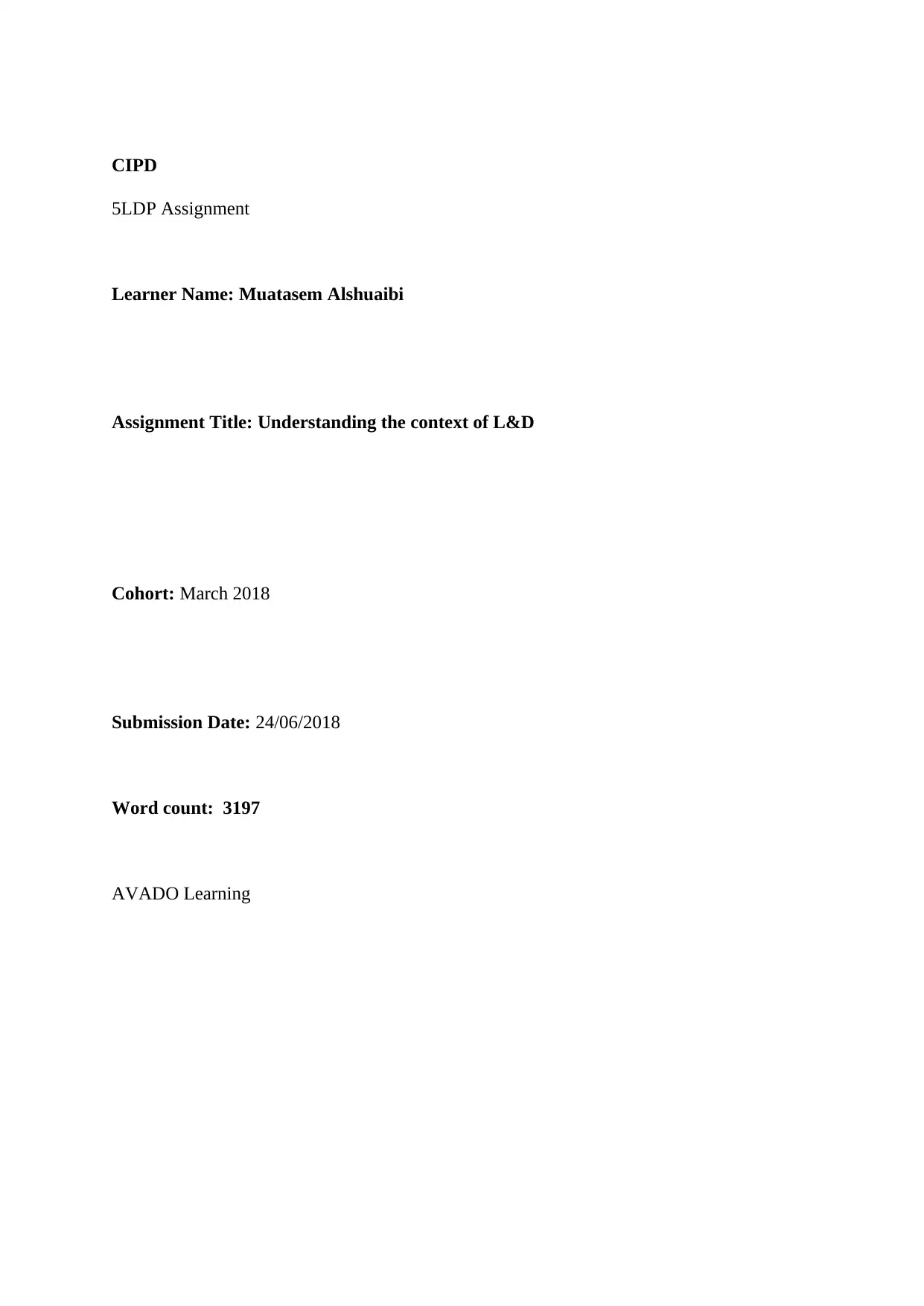
CIPD
5LDP Assignment
Learner Name: Muatasem Alshuaibi
Assignment Title: Understanding the context of L&D
Cohort: March 2018
Submission Date: 24/06/2018
Word count: 3197
AVADO Learning
5LDP Assignment
Learner Name: Muatasem Alshuaibi
Assignment Title: Understanding the context of L&D
Cohort: March 2018
Submission Date: 24/06/2018
Word count: 3197
AVADO Learning
Paraphrase This Document
Need a fresh take? Get an instant paraphrase of this document with our AI Paraphraser
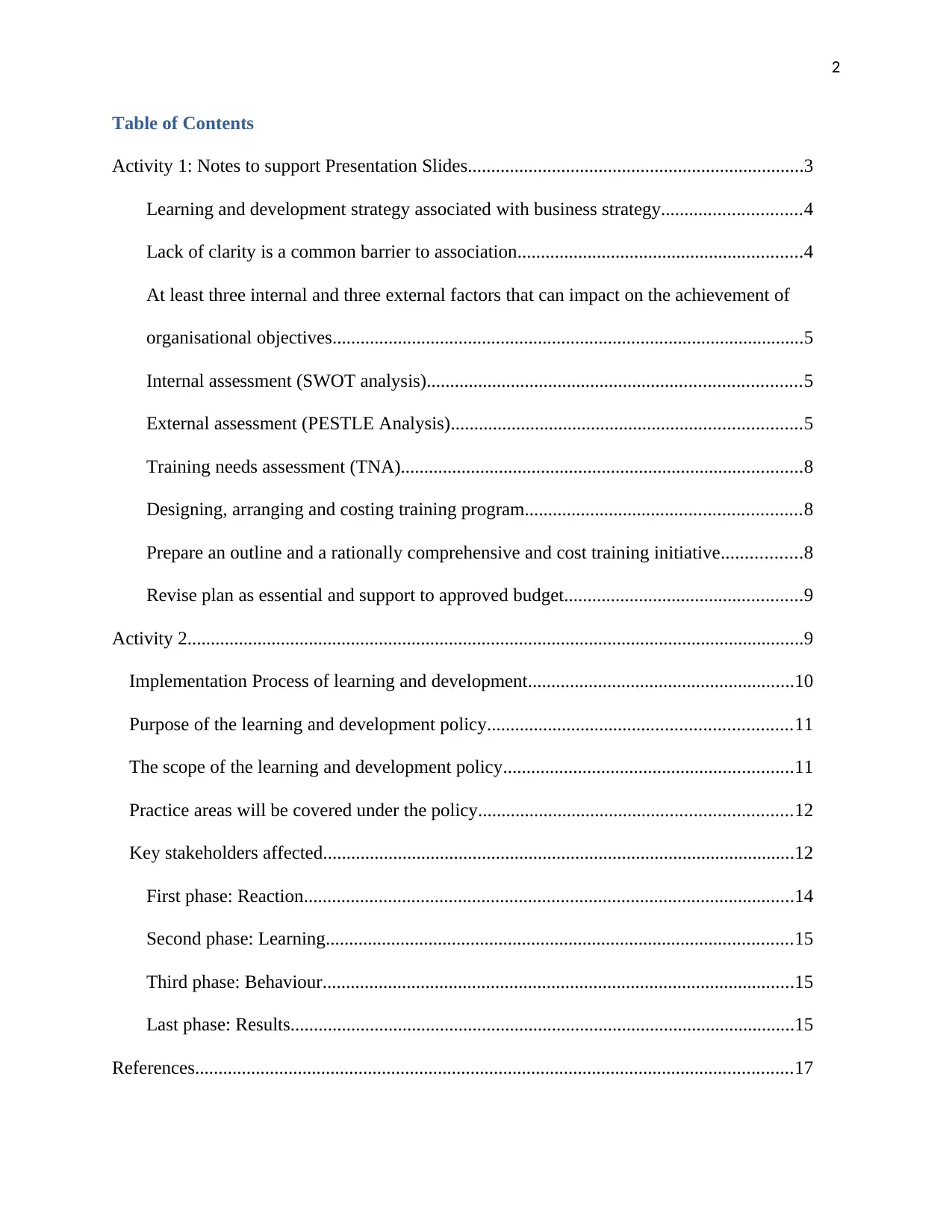
2
Table of Contents
Activity 1: Notes to support Presentation Slides........................................................................3
Learning and development strategy associated with business strategy..............................4
Lack of clarity is a common barrier to association.............................................................4
At least three internal and three external factors that can impact on the achievement of
organisational objectives.....................................................................................................5
Internal assessment (SWOT analysis)................................................................................5
External assessment (PESTLE Analysis)...........................................................................5
Training needs assessment (TNA)......................................................................................8
Designing, arranging and costing training program...........................................................8
Prepare an outline and a rationally comprehensive and cost training initiative.................8
Revise plan as essential and support to approved budget...................................................9
Activity 2....................................................................................................................................9
Implementation Process of learning and development.........................................................10
Purpose of the learning and development policy.................................................................11
The scope of the learning and development policy..............................................................11
Practice areas will be covered under the policy...................................................................12
Key stakeholders affected.....................................................................................................12
First phase: Reaction.........................................................................................................14
Second phase: Learning....................................................................................................15
Third phase: Behaviour.....................................................................................................15
Last phase: Results............................................................................................................15
References................................................................................................................................17
Table of Contents
Activity 1: Notes to support Presentation Slides........................................................................3
Learning and development strategy associated with business strategy..............................4
Lack of clarity is a common barrier to association.............................................................4
At least three internal and three external factors that can impact on the achievement of
organisational objectives.....................................................................................................5
Internal assessment (SWOT analysis)................................................................................5
External assessment (PESTLE Analysis)...........................................................................5
Training needs assessment (TNA)......................................................................................8
Designing, arranging and costing training program...........................................................8
Prepare an outline and a rationally comprehensive and cost training initiative.................8
Revise plan as essential and support to approved budget...................................................9
Activity 2....................................................................................................................................9
Implementation Process of learning and development.........................................................10
Purpose of the learning and development policy.................................................................11
The scope of the learning and development policy..............................................................11
Practice areas will be covered under the policy...................................................................12
Key stakeholders affected.....................................................................................................12
First phase: Reaction.........................................................................................................14
Second phase: Learning....................................................................................................15
Third phase: Behaviour.....................................................................................................15
Last phase: Results............................................................................................................15
References................................................................................................................................17

3
Appendix..................................................................................................................................20
Appendix..................................................................................................................................20
⊘ This is a preview!⊘
Do you want full access?
Subscribe today to unlock all pages.

Trusted by 1+ million students worldwide
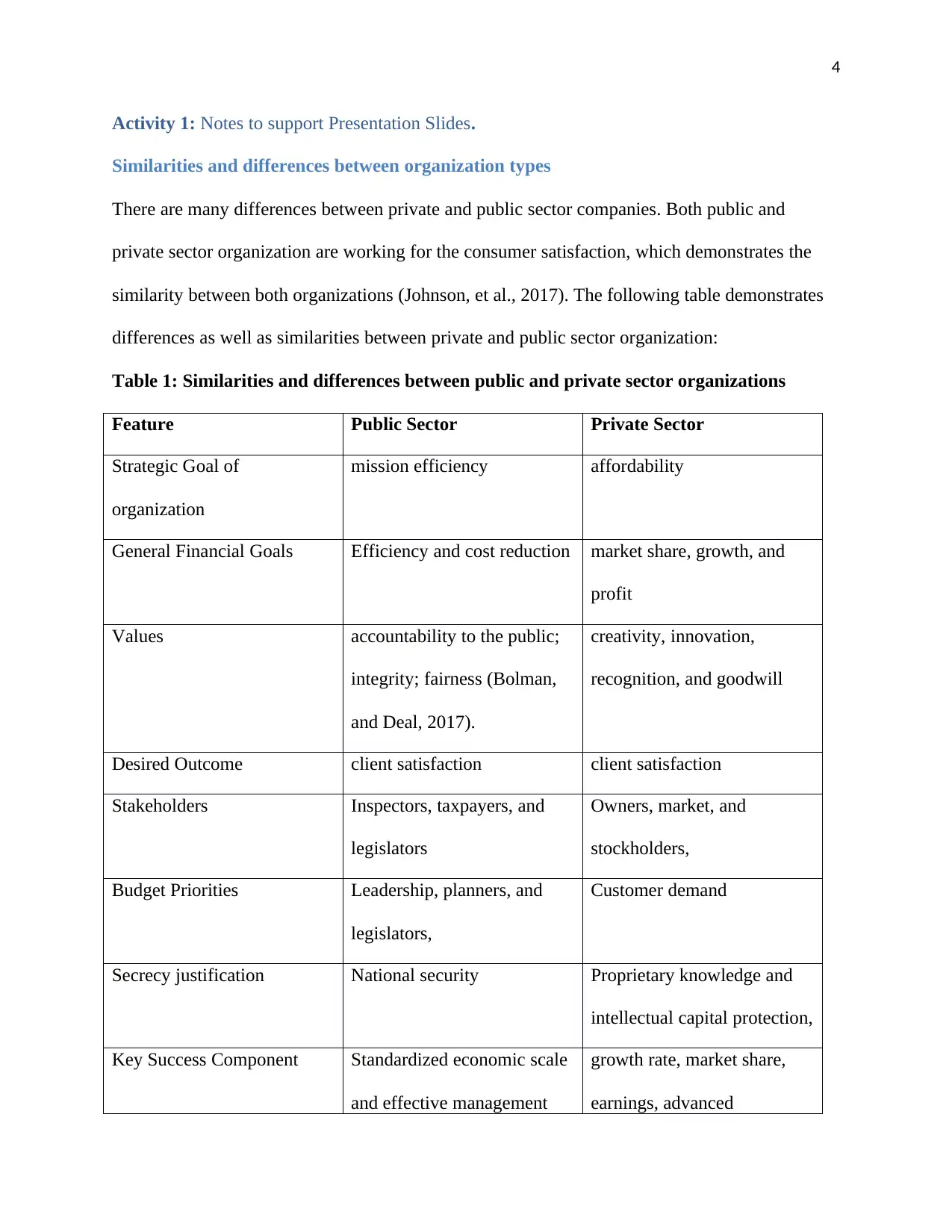
4
Activity 1: Notes to support Presentation Slides.
Similarities and differences between organization types
There are many differences between private and public sector companies. Both public and
private sector organization are working for the consumer satisfaction, which demonstrates the
similarity between both organizations (Johnson, et al., 2017). The following table demonstrates
differences as well as similarities between private and public sector organization:
Table 1: Similarities and differences between public and private sector organizations
Feature Public Sector Private Sector
Strategic Goal of
organization
mission efficiency affordability
General Financial Goals Efficiency and cost reduction market share, growth, and
profit
Values accountability to the public;
integrity; fairness (Bolman,
and Deal, 2017).
creativity, innovation,
recognition, and goodwill
Desired Outcome client satisfaction client satisfaction
Stakeholders Inspectors, taxpayers, and
legislators
Owners, market, and
stockholders,
Budget Priorities Leadership, planners, and
legislators,
Customer demand
Secrecy justification National security Proprietary knowledge and
intellectual capital protection,
Key Success Component Standardized economic scale
and effective management
growth rate, market share,
earnings, advanced
Activity 1: Notes to support Presentation Slides.
Similarities and differences between organization types
There are many differences between private and public sector companies. Both public and
private sector organization are working for the consumer satisfaction, which demonstrates the
similarity between both organizations (Johnson, et al., 2017). The following table demonstrates
differences as well as similarities between private and public sector organization:
Table 1: Similarities and differences between public and private sector organizations
Feature Public Sector Private Sector
Strategic Goal of
organization
mission efficiency affordability
General Financial Goals Efficiency and cost reduction market share, growth, and
profit
Values accountability to the public;
integrity; fairness (Bolman,
and Deal, 2017).
creativity, innovation,
recognition, and goodwill
Desired Outcome client satisfaction client satisfaction
Stakeholders Inspectors, taxpayers, and
legislators
Owners, market, and
stockholders,
Budget Priorities Leadership, planners, and
legislators,
Customer demand
Secrecy justification National security Proprietary knowledge and
intellectual capital protection,
Key Success Component Standardized economic scale
and effective management
growth rate, market share,
earnings, advanced
Paraphrase This Document
Need a fresh take? Get an instant paraphrase of this document with our AI Paraphraser
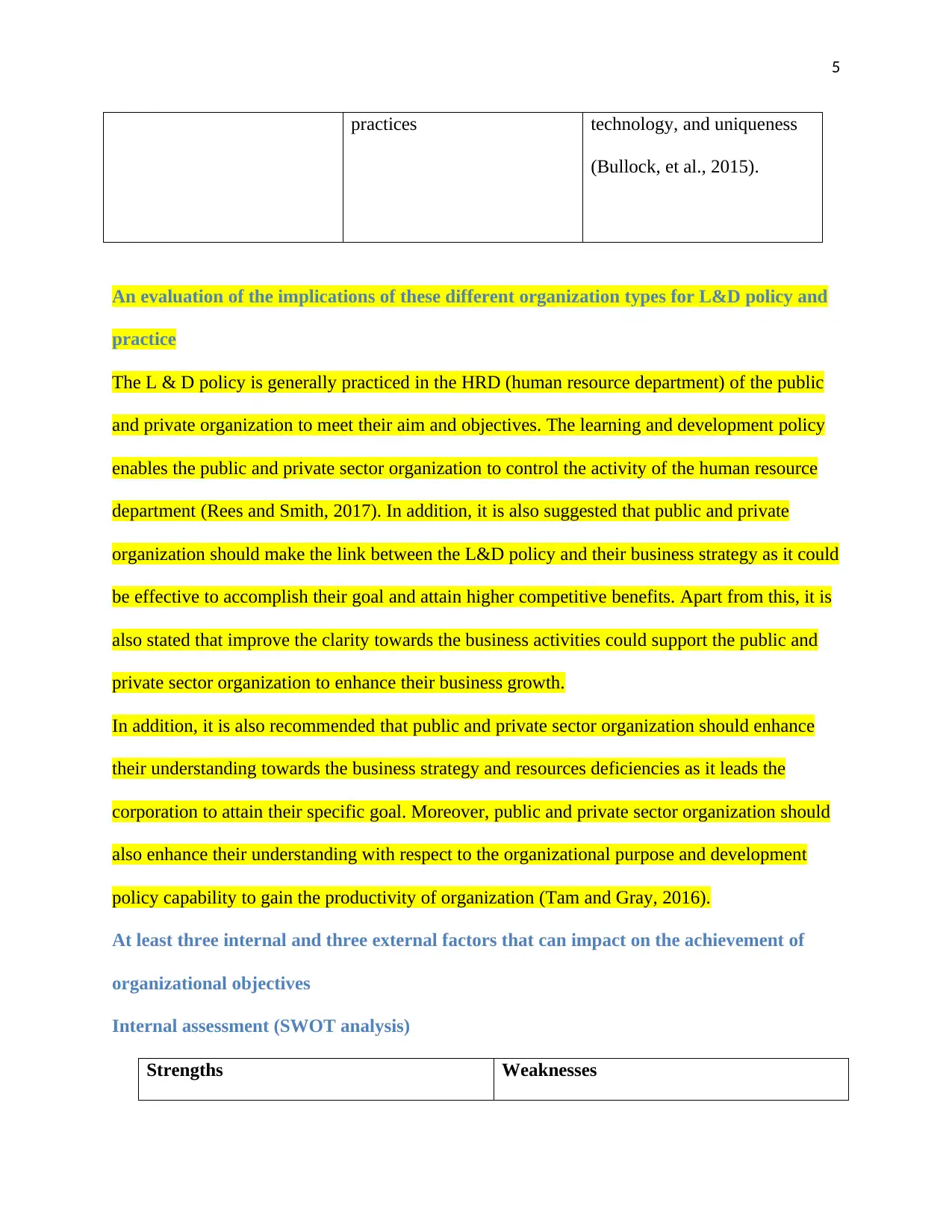
5
practices technology, and uniqueness
(Bullock, et al., 2015).
An evaluation of the implications of these different organization types for L&D policy and
practice
The L & D policy is generally practiced in the HRD (human resource department) of the public
and private organization to meet their aim and objectives. The learning and development policy
enables the public and private sector organization to control the activity of the human resource
department (Rees and Smith, 2017). In addition, it is also suggested that public and private
organization should make the link between the L&D policy and their business strategy as it could
be effective to accomplish their goal and attain higher competitive benefits. Apart from this, it is
also stated that improve the clarity towards the business activities could support the public and
private sector organization to enhance their business growth.
In addition, it is also recommended that public and private sector organization should enhance
their understanding towards the business strategy and resources deficiencies as it leads the
corporation to attain their specific goal. Moreover, public and private sector organization should
also enhance their understanding with respect to the organizational purpose and development
policy capability to gain the productivity of organization (Tam and Gray, 2016).
At least three internal and three external factors that can impact on the achievement of
organizational objectives
Internal assessment (SWOT analysis)
Strengths Weaknesses
practices technology, and uniqueness
(Bullock, et al., 2015).
An evaluation of the implications of these different organization types for L&D policy and
practice
The L & D policy is generally practiced in the HRD (human resource department) of the public
and private organization to meet their aim and objectives. The learning and development policy
enables the public and private sector organization to control the activity of the human resource
department (Rees and Smith, 2017). In addition, it is also suggested that public and private
organization should make the link between the L&D policy and their business strategy as it could
be effective to accomplish their goal and attain higher competitive benefits. Apart from this, it is
also stated that improve the clarity towards the business activities could support the public and
private sector organization to enhance their business growth.
In addition, it is also recommended that public and private sector organization should enhance
their understanding towards the business strategy and resources deficiencies as it leads the
corporation to attain their specific goal. Moreover, public and private sector organization should
also enhance their understanding with respect to the organizational purpose and development
policy capability to gain the productivity of organization (Tam and Gray, 2016).
At least three internal and three external factors that can impact on the achievement of
organizational objectives
Internal assessment (SWOT analysis)
Strengths Weaknesses
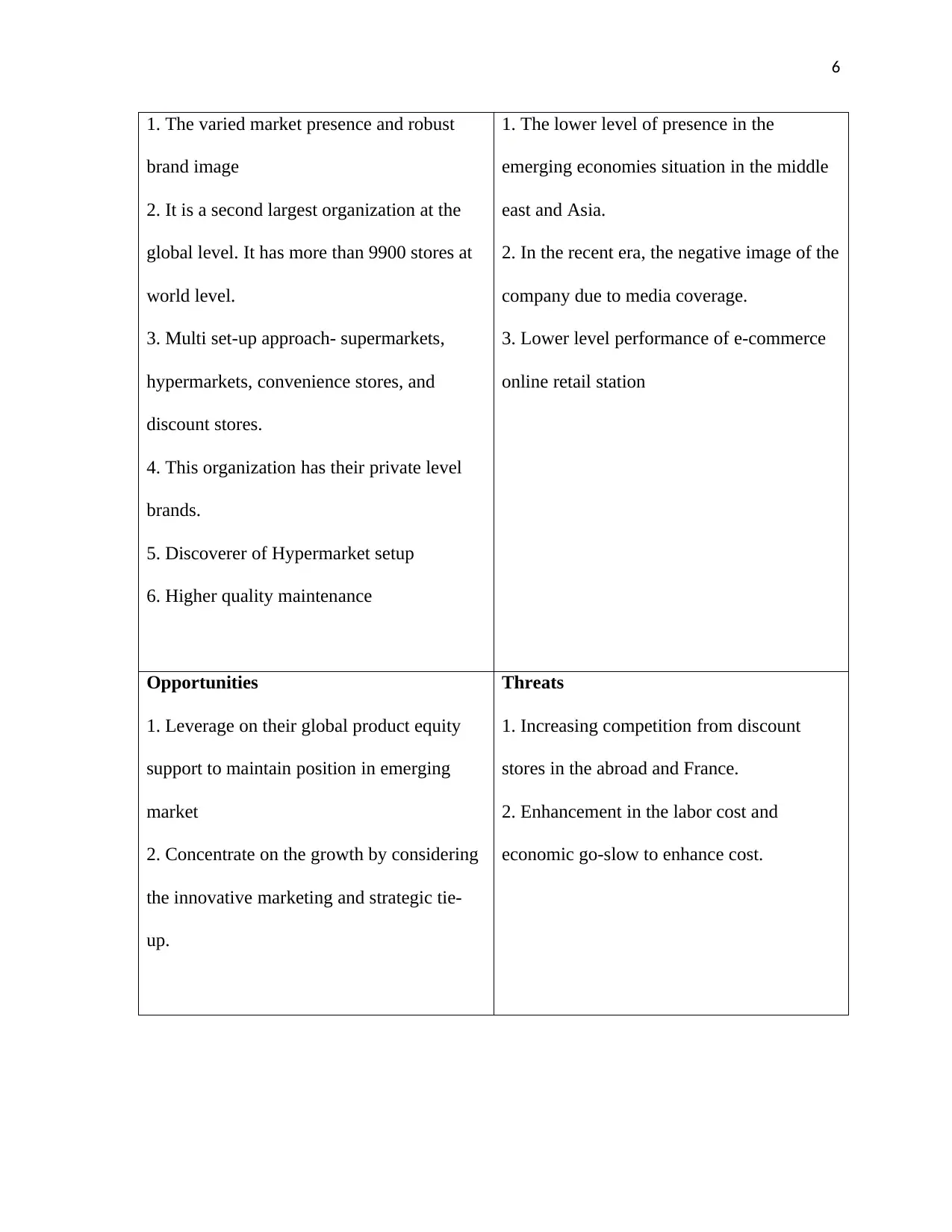
6
1. The varied market presence and robust
brand image
2. It is a second largest organization at the
global level. It has more than 9900 stores at
world level.
3. Multi set-up approach- supermarkets,
hypermarkets, convenience stores, and
discount stores.
4. This organization has their private level
brands.
5. Discoverer of Hypermarket setup
6. Higher quality maintenance
1. The lower level of presence in the
emerging economies situation in the middle
east and Asia.
2. In the recent era, the negative image of the
company due to media coverage.
3. Lower level performance of e-commerce
online retail station
Opportunities
1. Leverage on their global product equity
support to maintain position in emerging
market
2. Concentrate on the growth by considering
the innovative marketing and strategic tie-
up.
Threats
1. Increasing competition from discount
stores in the abroad and France.
2. Enhancement in the labor cost and
economic go-slow to enhance cost.
1. The varied market presence and robust
brand image
2. It is a second largest organization at the
global level. It has more than 9900 stores at
world level.
3. Multi set-up approach- supermarkets,
hypermarkets, convenience stores, and
discount stores.
4. This organization has their private level
brands.
5. Discoverer of Hypermarket setup
6. Higher quality maintenance
1. The lower level of presence in the
emerging economies situation in the middle
east and Asia.
2. In the recent era, the negative image of the
company due to media coverage.
3. Lower level performance of e-commerce
online retail station
Opportunities
1. Leverage on their global product equity
support to maintain position in emerging
market
2. Concentrate on the growth by considering
the innovative marketing and strategic tie-
up.
Threats
1. Increasing competition from discount
stores in the abroad and France.
2. Enhancement in the labor cost and
economic go-slow to enhance cost.
⊘ This is a preview!⊘
Do you want full access?
Subscribe today to unlock all pages.

Trusted by 1+ million students worldwide
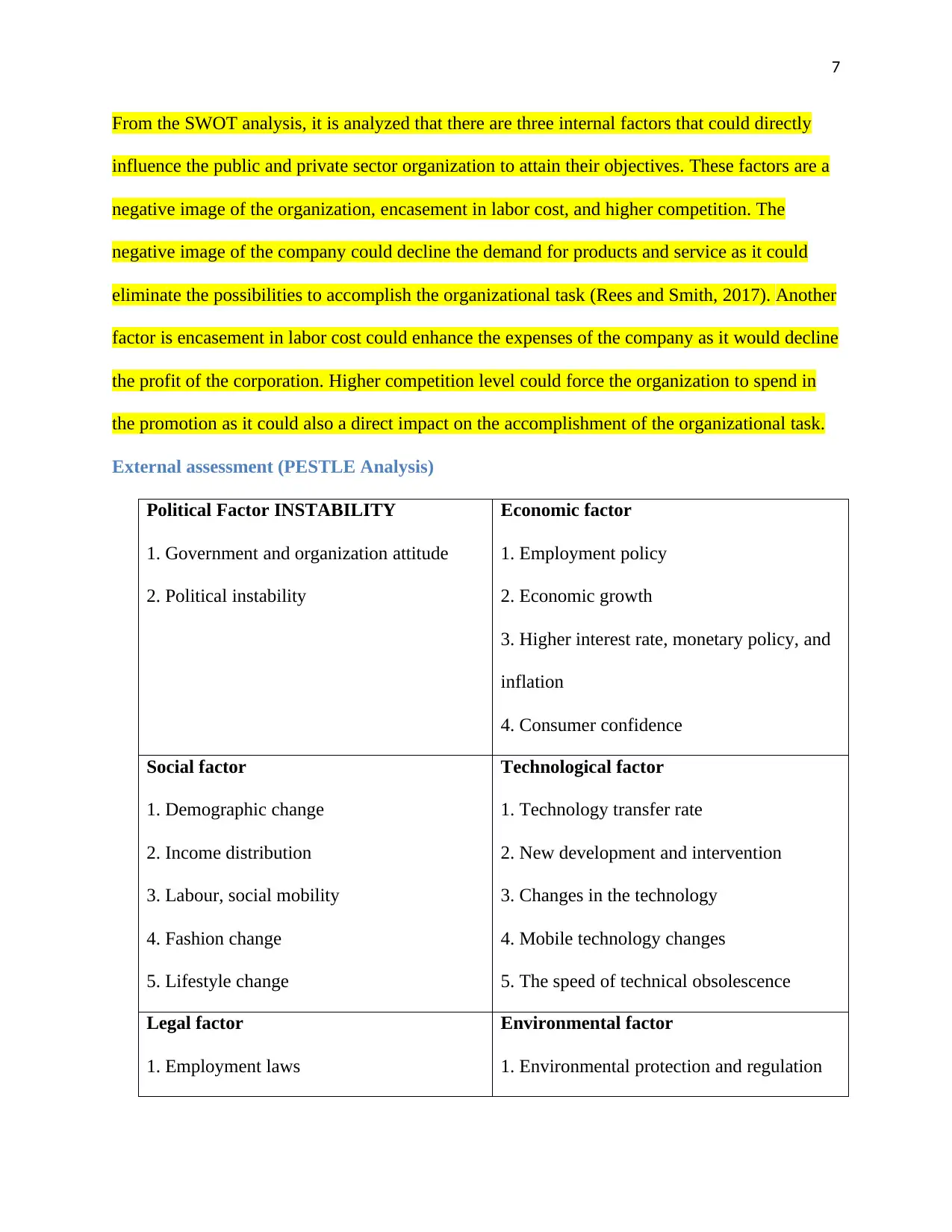
7
From the SWOT analysis, it is analyzed that there are three internal factors that could directly
influence the public and private sector organization to attain their objectives. These factors are a
negative image of the organization, encasement in labor cost, and higher competition. The
negative image of the company could decline the demand for products and service as it could
eliminate the possibilities to accomplish the organizational task (Rees and Smith, 2017). Another
factor is encasement in labor cost could enhance the expenses of the company as it would decline
the profit of the corporation. Higher competition level could force the organization to spend in
the promotion as it could also a direct impact on the accomplishment of the organizational task.
External assessment (PESTLE Analysis)
Political Factor INSTABILITY
1. Government and organization attitude
2. Political instability
Economic factor
1. Employment policy
2. Economic growth
3. Higher interest rate, monetary policy, and
inflation
4. Consumer confidence
Social factor
1. Demographic change
2. Income distribution
3. Labour, social mobility
4. Fashion change
5. Lifestyle change
Technological factor
1. Technology transfer rate
2. New development and intervention
3. Changes in the technology
4. Mobile technology changes
5. The speed of technical obsolescence
Legal factor
1. Employment laws
Environmental factor
1. Environmental protection and regulation
From the SWOT analysis, it is analyzed that there are three internal factors that could directly
influence the public and private sector organization to attain their objectives. These factors are a
negative image of the organization, encasement in labor cost, and higher competition. The
negative image of the company could decline the demand for products and service as it could
eliminate the possibilities to accomplish the organizational task (Rees and Smith, 2017). Another
factor is encasement in labor cost could enhance the expenses of the company as it would decline
the profit of the corporation. Higher competition level could force the organization to spend in
the promotion as it could also a direct impact on the accomplishment of the organizational task.
External assessment (PESTLE Analysis)
Political Factor INSTABILITY
1. Government and organization attitude
2. Political instability
Economic factor
1. Employment policy
2. Economic growth
3. Higher interest rate, monetary policy, and
inflation
4. Consumer confidence
Social factor
1. Demographic change
2. Income distribution
3. Labour, social mobility
4. Fashion change
5. Lifestyle change
Technological factor
1. Technology transfer rate
2. New development and intervention
3. Changes in the technology
4. Mobile technology changes
5. The speed of technical obsolescence
Legal factor
1. Employment laws
Environmental factor
1. Environmental protection and regulation
Paraphrase This Document
Need a fresh take? Get an instant paraphrase of this document with our AI Paraphraser
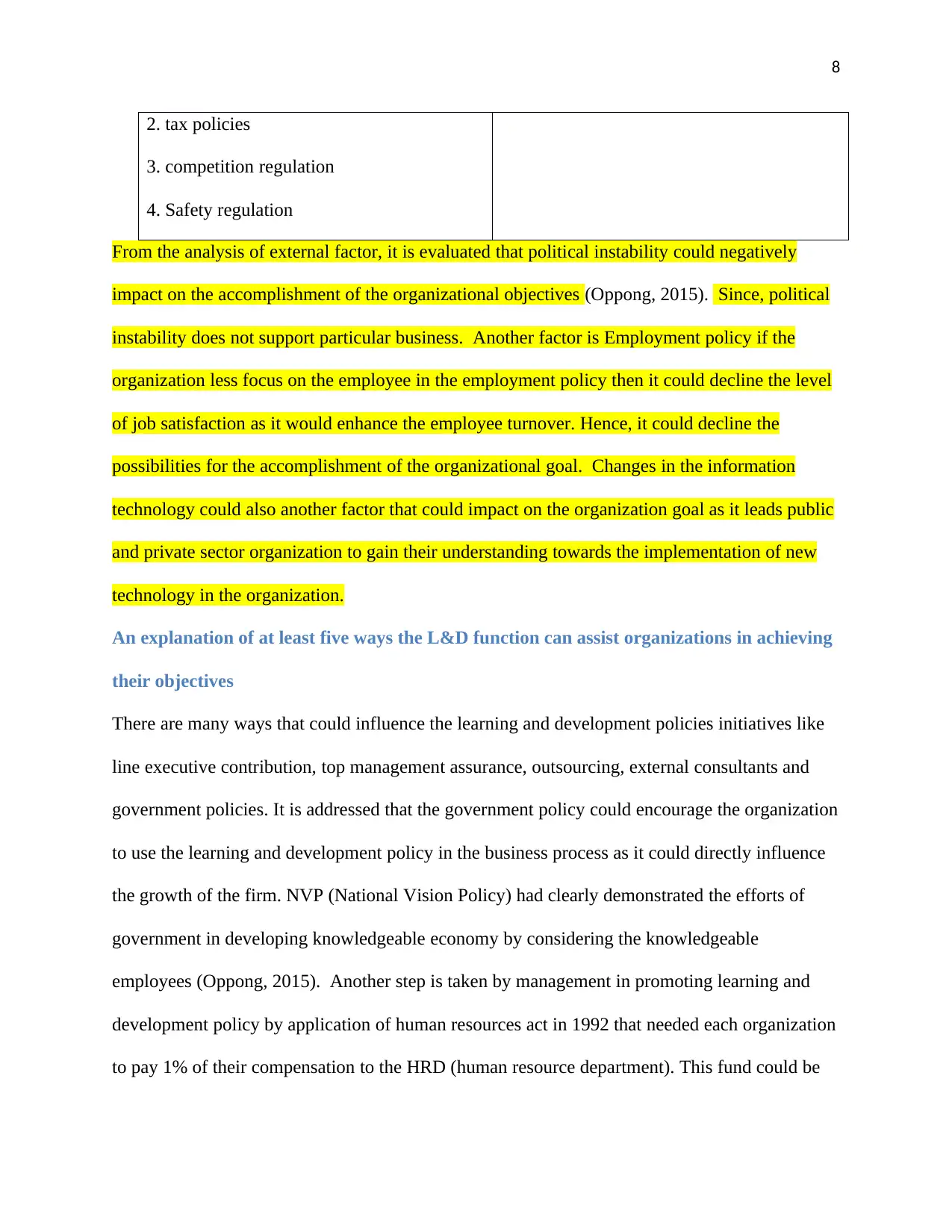
8
2. tax policies
3. competition regulation
4. Safety regulation
From the analysis of external factor, it is evaluated that political instability could negatively
impact on the accomplishment of the organizational objectives (Oppong, 2015). Since, political
instability does not support particular business. Another factor is Employment policy if the
organization less focus on the employee in the employment policy then it could decline the level
of job satisfaction as it would enhance the employee turnover. Hence, it could decline the
possibilities for the accomplishment of the organizational goal. Changes in the information
technology could also another factor that could impact on the organization goal as it leads public
and private sector organization to gain their understanding towards the implementation of new
technology in the organization.
An explanation of at least five ways the L&D function can assist organizations in achieving
their objectives
There are many ways that could influence the learning and development policies initiatives like
line executive contribution, top management assurance, outsourcing, external consultants and
government policies. It is addressed that the government policy could encourage the organization
to use the learning and development policy in the business process as it could directly influence
the growth of the firm. NVP (National Vision Policy) had clearly demonstrated the efforts of
government in developing knowledgeable economy by considering the knowledgeable
employees (Oppong, 2015). Another step is taken by management in promoting learning and
development policy by application of human resources act in 1992 that needed each organization
to pay 1% of their compensation to the HRD (human resource department). This fund could be
2. tax policies
3. competition regulation
4. Safety regulation
From the analysis of external factor, it is evaluated that political instability could negatively
impact on the accomplishment of the organizational objectives (Oppong, 2015). Since, political
instability does not support particular business. Another factor is Employment policy if the
organization less focus on the employee in the employment policy then it could decline the level
of job satisfaction as it would enhance the employee turnover. Hence, it could decline the
possibilities for the accomplishment of the organizational goal. Changes in the information
technology could also another factor that could impact on the organization goal as it leads public
and private sector organization to gain their understanding towards the implementation of new
technology in the organization.
An explanation of at least five ways the L&D function can assist organizations in achieving
their objectives
There are many ways that could influence the learning and development policies initiatives like
line executive contribution, top management assurance, outsourcing, external consultants and
government policies. It is addressed that the government policy could encourage the organization
to use the learning and development policy in the business process as it could directly influence
the growth of the firm. NVP (National Vision Policy) had clearly demonstrated the efforts of
government in developing knowledgeable economy by considering the knowledgeable
employees (Oppong, 2015). Another step is taken by management in promoting learning and
development policy by application of human resources act in 1992 that needed each organization
to pay 1% of their compensation to the HRD (human resource department). This fund could be
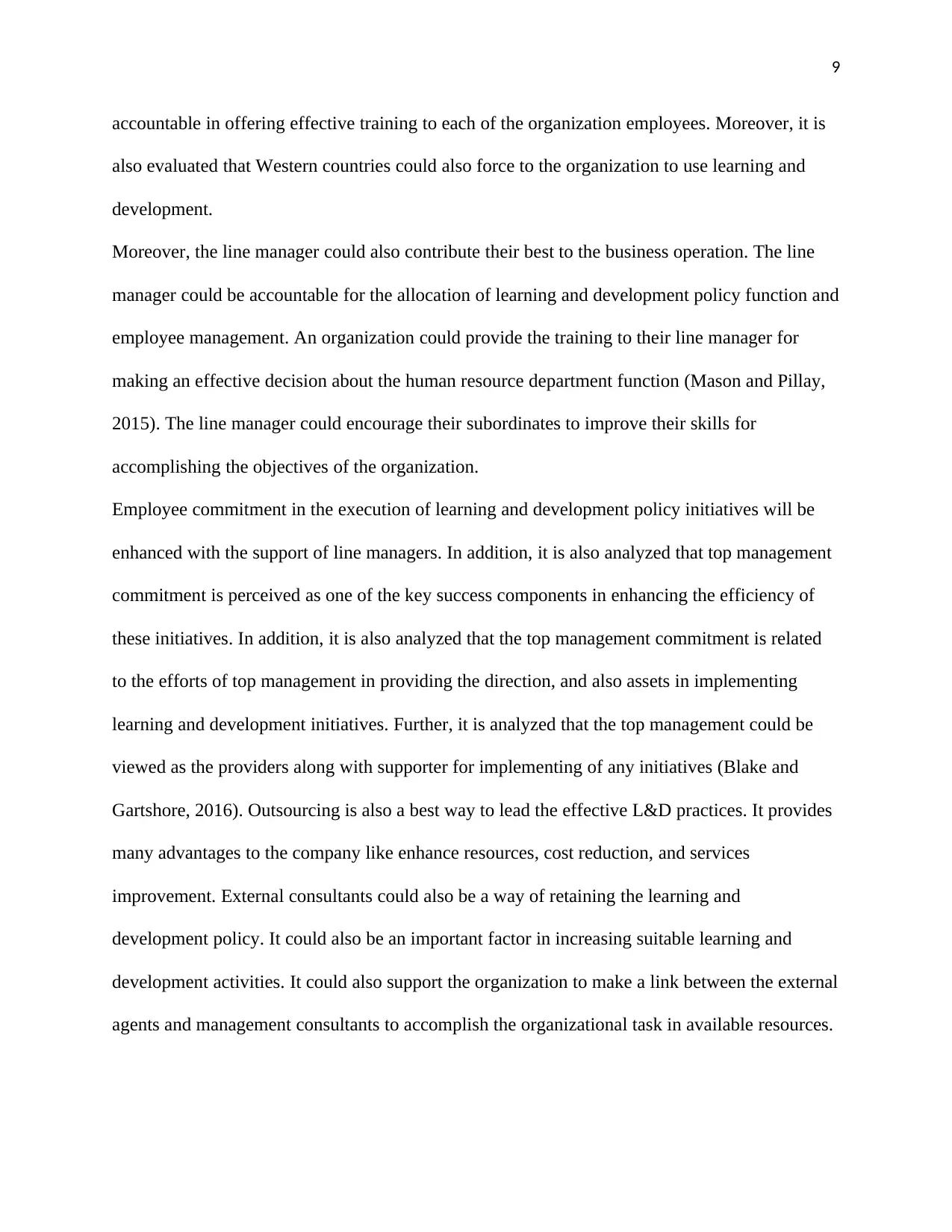
9
accountable in offering effective training to each of the organization employees. Moreover, it is
also evaluated that Western countries could also force to the organization to use learning and
development.
Moreover, the line manager could also contribute their best to the business operation. The line
manager could be accountable for the allocation of learning and development policy function and
employee management. An organization could provide the training to their line manager for
making an effective decision about the human resource department function (Mason and Pillay,
2015). The line manager could encourage their subordinates to improve their skills for
accomplishing the objectives of the organization.
Employee commitment in the execution of learning and development policy initiatives will be
enhanced with the support of line managers. In addition, it is also analyzed that top management
commitment is perceived as one of the key success components in enhancing the efficiency of
these initiatives. In addition, it is also analyzed that the top management commitment is related
to the efforts of top management in providing the direction, and also assets in implementing
learning and development initiatives. Further, it is analyzed that the top management could be
viewed as the providers along with supporter for implementing of any initiatives (Blake and
Gartshore, 2016). Outsourcing is also a best way to lead the effective L&D practices. It provides
many advantages to the company like enhance resources, cost reduction, and services
improvement. External consultants could also be a way of retaining the learning and
development policy. It could also be an important factor in increasing suitable learning and
development activities. It could also support the organization to make a link between the external
agents and management consultants to accomplish the organizational task in available resources.
accountable in offering effective training to each of the organization employees. Moreover, it is
also evaluated that Western countries could also force to the organization to use learning and
development.
Moreover, the line manager could also contribute their best to the business operation. The line
manager could be accountable for the allocation of learning and development policy function and
employee management. An organization could provide the training to their line manager for
making an effective decision about the human resource department function (Mason and Pillay,
2015). The line manager could encourage their subordinates to improve their skills for
accomplishing the objectives of the organization.
Employee commitment in the execution of learning and development policy initiatives will be
enhanced with the support of line managers. In addition, it is also analyzed that top management
commitment is perceived as one of the key success components in enhancing the efficiency of
these initiatives. In addition, it is also analyzed that the top management commitment is related
to the efforts of top management in providing the direction, and also assets in implementing
learning and development initiatives. Further, it is analyzed that the top management could be
viewed as the providers along with supporter for implementing of any initiatives (Blake and
Gartshore, 2016). Outsourcing is also a best way to lead the effective L&D practices. It provides
many advantages to the company like enhance resources, cost reduction, and services
improvement. External consultants could also be a way of retaining the learning and
development policy. It could also be an important factor in increasing suitable learning and
development activities. It could also support the organization to make a link between the external
agents and management consultants to accomplish the organizational task in available resources.
⊘ This is a preview!⊘
Do you want full access?
Subscribe today to unlock all pages.

Trusted by 1+ million students worldwide
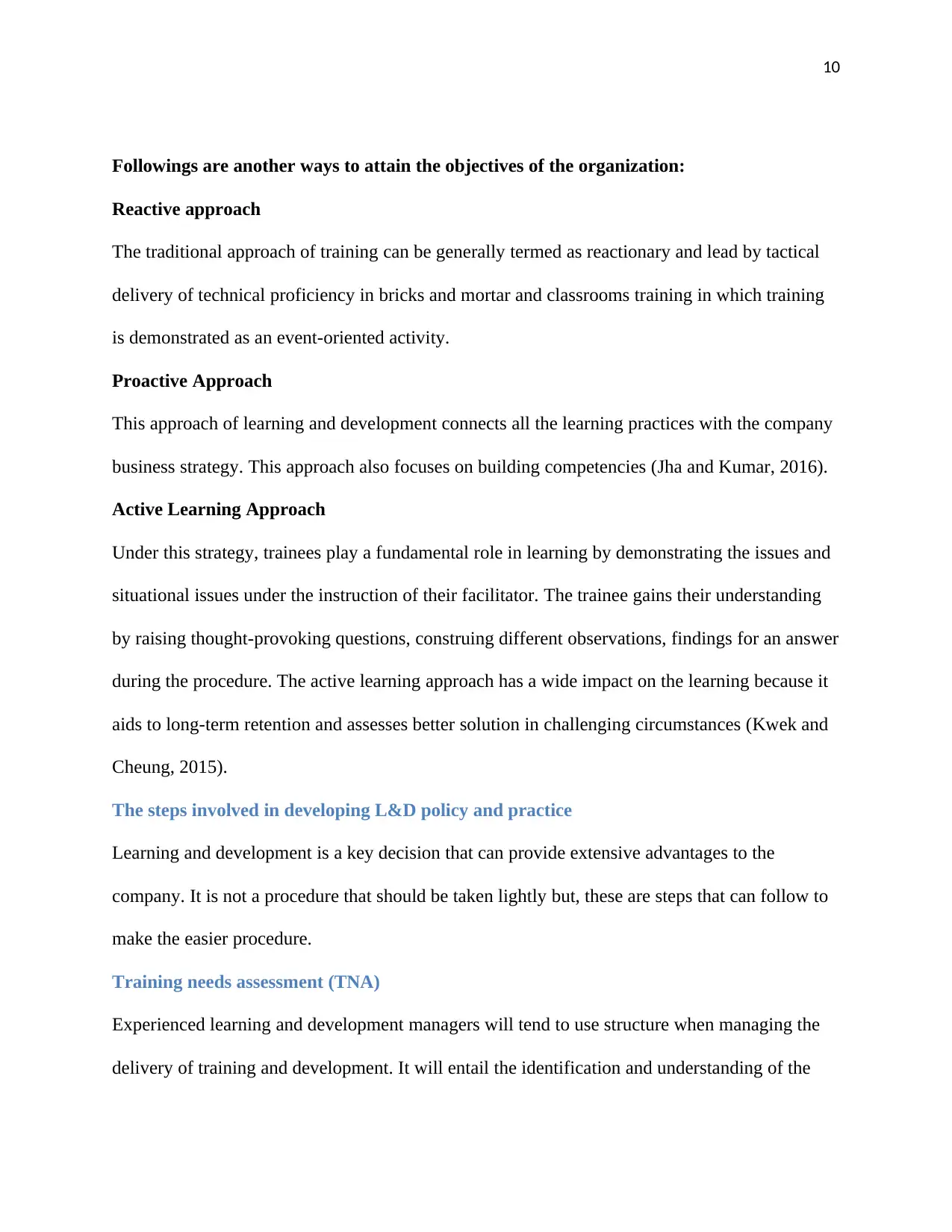
10
Followings are another ways to attain the objectives of the organization:
Reactive approach
The traditional approach of training can be generally termed as reactionary and lead by tactical
delivery of technical proficiency in bricks and mortar and classrooms training in which training
is demonstrated as an event-oriented activity.
Proactive Approach
This approach of learning and development connects all the learning practices with the company
business strategy. This approach also focuses on building competencies (Jha and Kumar, 2016).
Active Learning Approach
Under this strategy, trainees play a fundamental role in learning by demonstrating the issues and
situational issues under the instruction of their facilitator. The trainee gains their understanding
by raising thought-provoking questions, construing different observations, findings for an answer
during the procedure. The active learning approach has a wide impact on the learning because it
aids to long-term retention and assesses better solution in challenging circumstances (Kwek and
Cheung, 2015).
The steps involved in developing L&D policy and practice
Learning and development is a key decision that can provide extensive advantages to the
company. It is not a procedure that should be taken lightly but, these are steps that can follow to
make the easier procedure.
Training needs assessment (TNA)
Experienced learning and development managers will tend to use structure when managing the
delivery of training and development. It will entail the identification and understanding of the
Followings are another ways to attain the objectives of the organization:
Reactive approach
The traditional approach of training can be generally termed as reactionary and lead by tactical
delivery of technical proficiency in bricks and mortar and classrooms training in which training
is demonstrated as an event-oriented activity.
Proactive Approach
This approach of learning and development connects all the learning practices with the company
business strategy. This approach also focuses on building competencies (Jha and Kumar, 2016).
Active Learning Approach
Under this strategy, trainees play a fundamental role in learning by demonstrating the issues and
situational issues under the instruction of their facilitator. The trainee gains their understanding
by raising thought-provoking questions, construing different observations, findings for an answer
during the procedure. The active learning approach has a wide impact on the learning because it
aids to long-term retention and assesses better solution in challenging circumstances (Kwek and
Cheung, 2015).
The steps involved in developing L&D policy and practice
Learning and development is a key decision that can provide extensive advantages to the
company. It is not a procedure that should be taken lightly but, these are steps that can follow to
make the easier procedure.
Training needs assessment (TNA)
Experienced learning and development managers will tend to use structure when managing the
delivery of training and development. It will entail the identification and understanding of the
Paraphrase This Document
Need a fresh take? Get an instant paraphrase of this document with our AI Paraphraser
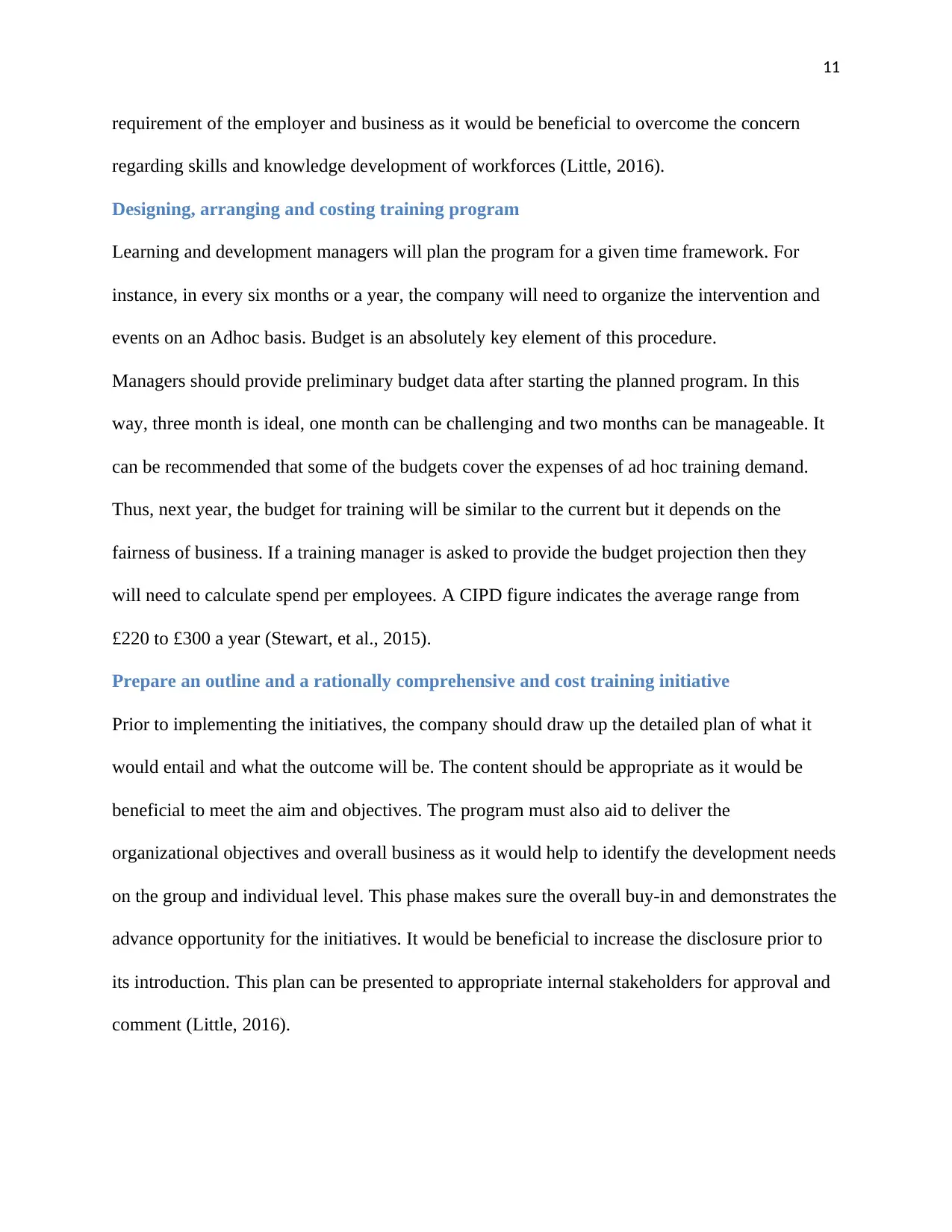
11
requirement of the employer and business as it would be beneficial to overcome the concern
regarding skills and knowledge development of workforces (Little, 2016).
Designing, arranging and costing training program
Learning and development managers will plan the program for a given time framework. For
instance, in every six months or a year, the company will need to organize the intervention and
events on an Adhoc basis. Budget is an absolutely key element of this procedure.
Managers should provide preliminary budget data after starting the planned program. In this
way, three month is ideal, one month can be challenging and two months can be manageable. It
can be recommended that some of the budgets cover the expenses of ad hoc training demand.
Thus, next year, the budget for training will be similar to the current but it depends on the
fairness of business. If a training manager is asked to provide the budget projection then they
will need to calculate spend per employees. A CIPD figure indicates the average range from
£220 to £300 a year (Stewart, et al., 2015).
Prepare an outline and a rationally comprehensive and cost training initiative
Prior to implementing the initiatives, the company should draw up the detailed plan of what it
would entail and what the outcome will be. The content should be appropriate as it would be
beneficial to meet the aim and objectives. The program must also aid to deliver the
organizational objectives and overall business as it would help to identify the development needs
on the group and individual level. This phase makes sure the overall buy-in and demonstrates the
advance opportunity for the initiatives. It would be beneficial to increase the disclosure prior to
its introduction. This plan can be presented to appropriate internal stakeholders for approval and
comment (Little, 2016).
requirement of the employer and business as it would be beneficial to overcome the concern
regarding skills and knowledge development of workforces (Little, 2016).
Designing, arranging and costing training program
Learning and development managers will plan the program for a given time framework. For
instance, in every six months or a year, the company will need to organize the intervention and
events on an Adhoc basis. Budget is an absolutely key element of this procedure.
Managers should provide preliminary budget data after starting the planned program. In this
way, three month is ideal, one month can be challenging and two months can be manageable. It
can be recommended that some of the budgets cover the expenses of ad hoc training demand.
Thus, next year, the budget for training will be similar to the current but it depends on the
fairness of business. If a training manager is asked to provide the budget projection then they
will need to calculate spend per employees. A CIPD figure indicates the average range from
£220 to £300 a year (Stewart, et al., 2015).
Prepare an outline and a rationally comprehensive and cost training initiative
Prior to implementing the initiatives, the company should draw up the detailed plan of what it
would entail and what the outcome will be. The content should be appropriate as it would be
beneficial to meet the aim and objectives. The program must also aid to deliver the
organizational objectives and overall business as it would help to identify the development needs
on the group and individual level. This phase makes sure the overall buy-in and demonstrates the
advance opportunity for the initiatives. It would be beneficial to increase the disclosure prior to
its introduction. This plan can be presented to appropriate internal stakeholders for approval and
comment (Little, 2016).
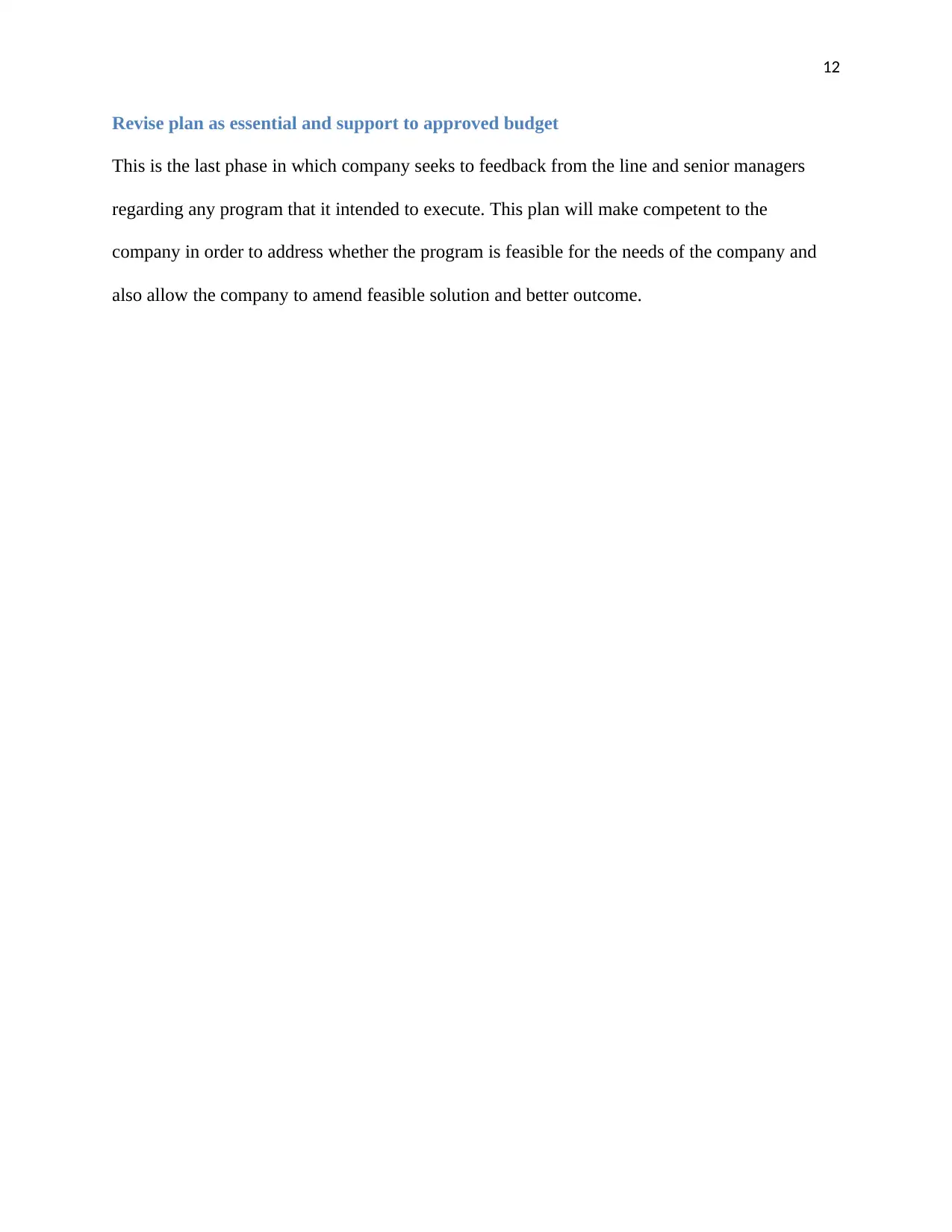
12
Revise plan as essential and support to approved budget
This is the last phase in which company seeks to feedback from the line and senior managers
regarding any program that it intended to execute. This plan will make competent to the
company in order to address whether the program is feasible for the needs of the company and
also allow the company to amend feasible solution and better outcome.
Revise plan as essential and support to approved budget
This is the last phase in which company seeks to feedback from the line and senior managers
regarding any program that it intended to execute. This plan will make competent to the
company in order to address whether the program is feasible for the needs of the company and
also allow the company to amend feasible solution and better outcome.
⊘ This is a preview!⊘
Do you want full access?
Subscribe today to unlock all pages.

Trusted by 1+ million students worldwide
1 out of 24
Related Documents
Your All-in-One AI-Powered Toolkit for Academic Success.
+13062052269
info@desklib.com
Available 24*7 on WhatsApp / Email
![[object Object]](/_next/static/media/star-bottom.7253800d.svg)
Unlock your academic potential
Copyright © 2020–2025 A2Z Services. All Rights Reserved. Developed and managed by ZUCOL.




